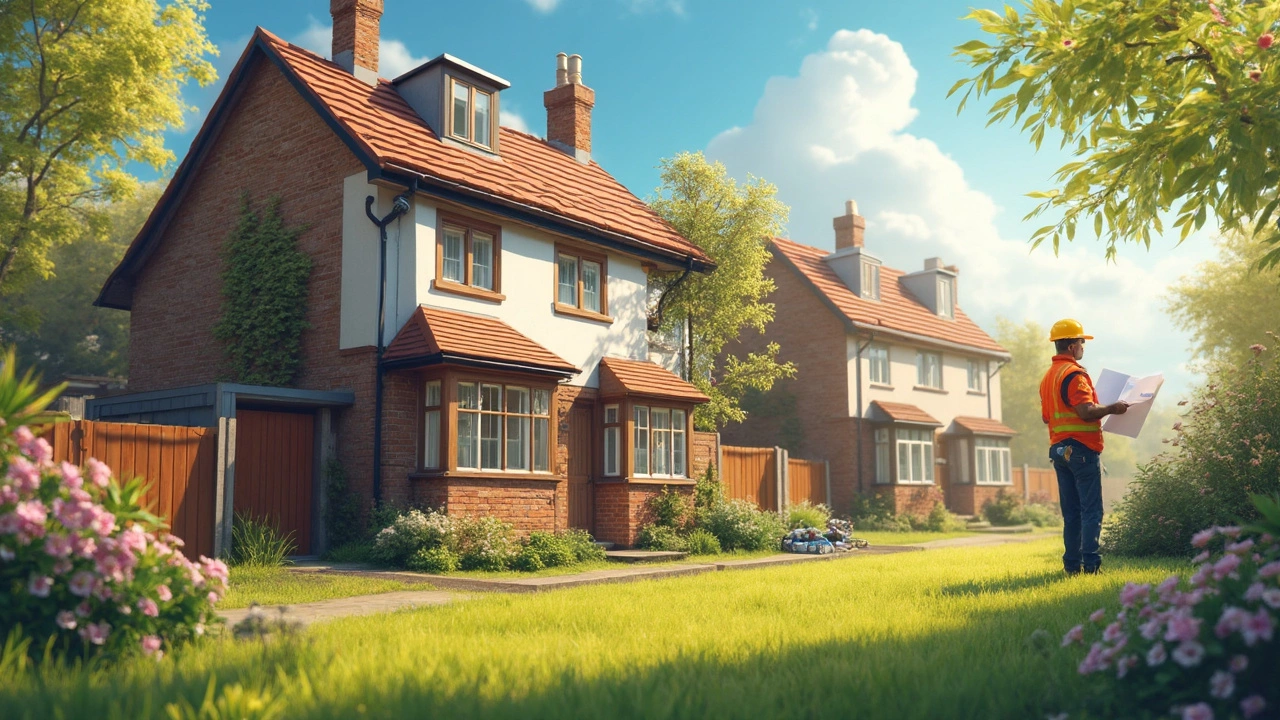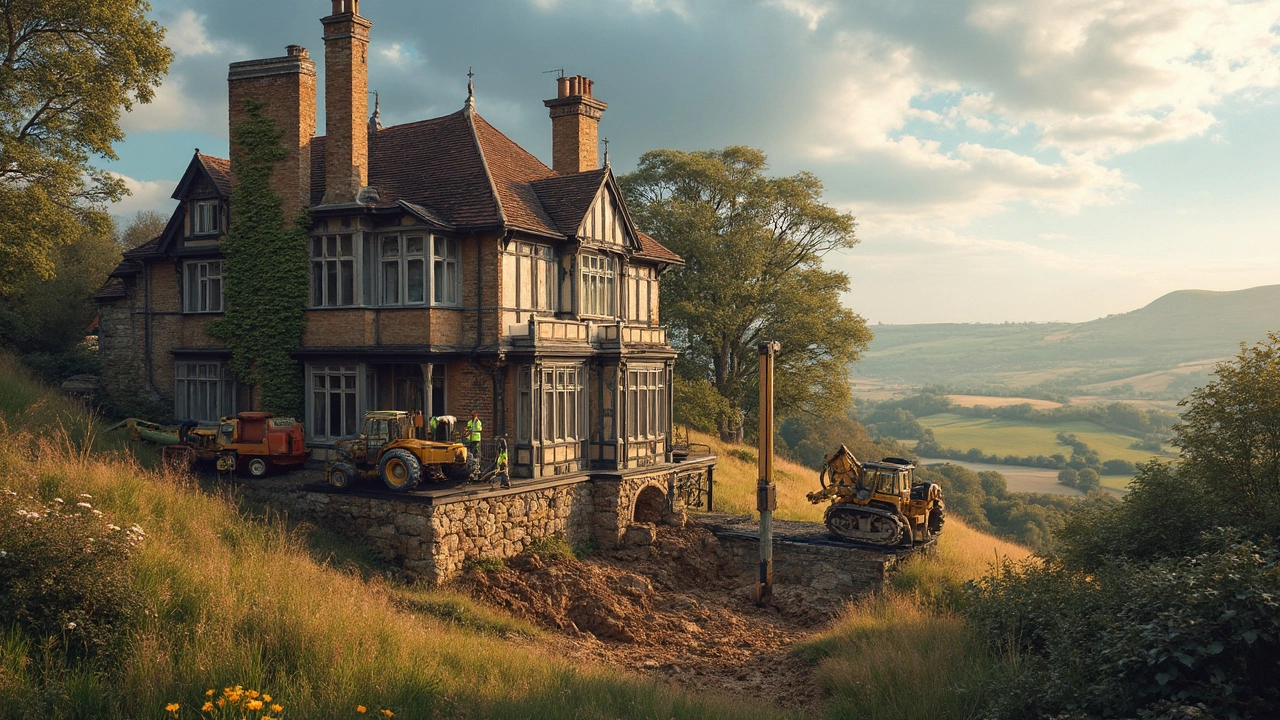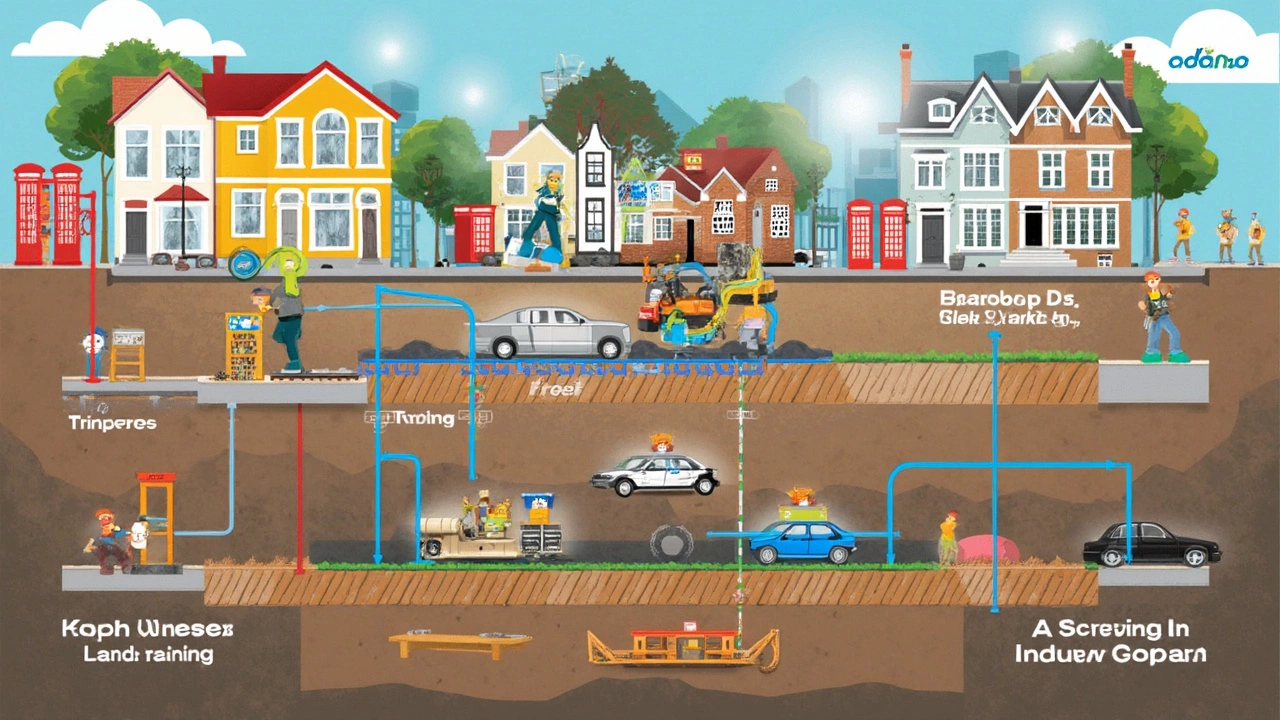Best Methods for Foundation Repair: Which One Should You Choose?
 Feb, 6 2025
Feb, 6 2025
Foundation repair might sound daunting, but understanding the methods used can make the process a lot less intimidating. Why do some foundations fail while others hold firm? Often, it's about soil moisture, temperature changes, or even the type of soil your home is sitting on. When the foundation cracks or settles, it's time to consider your repair options before things get trickier.
One common technique is slab jacking. Think of it like giving your foundation a lift. This method injects a special mixture beneath the settled concrete slab, raising it back to its original position. It's less invasive, quicker, and a bit friendlier on the budget compared to other methods. The best part? You’re not ripping apart floors—your lawn stays intact!
Understanding Foundation Problems
Start by walking around your house—but don't forget to look down! Keeping an eye on your foundation can save you from big headaches down the road. What are the signs you need to be aware of? Well, look out for cracks in the walls and floors, doors that won’t close, or even windows getting stuck. These clues might point to underlying foundation repair issues.
Why Foundations Fail
There are a bunch of reasons why foundations run into trouble. The soil beneath your home is often the big culprit. If it expands and contracts with weather changes, it can shift the very ground your home stands on. Also, too much water can cause the soil to become soggy, weakening its ability to hold up the foundation walls.
Types of Foundation Problems
Problems can arise in different flavors, each requiring different fixes. You might encounter:
- Settling: Parts of your home sinking, leading to an uneven foundation.
- Cracks: Visible tears in the foundation, sometimes letting water sneak in.
- Heaving: The foundation being pushed upwards by expanding soil.
With these problems, things can start small but quickly get messy. Taking early action can help stop minor issues from turning into expensive repairs.
The Role of Weather
Ever notice how your house behaves differently during different times of the year? Temperature and moisture shifts can play havoc with your foundation. During dry spells, soil shrinks away from your home, while in wet seasons, it swells up. These are massive stress tests for a foundation.
Interestingly, studies have shown that homes built on clay-rich soil are particularly vulnerable. Clay is like a sponge—when it rains, it absorbs water and swells. When dry, it shrinks and cracks. This kind of volatile movement can lead to a lot of shifting.
What Does This Mean for You?
Keep tabs on any changes in your home’s structure. Early recognition and understanding of these foundation concerns can save you both time and expense in future repair work. Knowledge really is power here. After all, prevention is a heck of a lot better than cure!
Slab Jacking
If your concrete slab is looking a little low, or maybe it's taken a nosedive on one side, slab jacking could be your saving grace. This foundation repair technique is all about giving that slab a lift without needing a full overhaul. It's like a chiropractor session, but for your floor!
How does it work exactly? Picture this: a crew drills small holes (we're talking just about an inch and a half) into the sunken area of the concrete. Then, they pump a mixture called grout—a slurry of sand, cement, and other materials—right into these holes. As the grout fills the voids below, up goes the concrete to its proper place. This is pretty handy for issues caused by soil washout or compaction.
Why Choose Slab Jacking?
The beauty of slab jacking is in its simplicity and effectiveness. First off, it's much quicker than many other foundation repair methods. Most jobs can be wrapped up in an afternoon, and you can walk on the surface almost immediately after. And let's be honest, any repair that doesn't leave your yard looking like it was attacked by moles scores major points!
Price-wise, slab jacking is generally more wallet-friendly compared to methods like piering. It usually costs half as much, which is a perk when you're juggling house maintenance budgets.
Is Slab Jacking Right for You?
- It's ideal for smaller, non-structural cracks in concrete slabs or your driveway.
- Works wonders in areas where water has caused washouts under your concrete.
- If the soil underneath has compacted over time, leading to settling, this could be your fix.
However, if you're noticing big structural issues or widespread cracks, it might be worth consulting about piering or other methods. Always best to check in with a pro to ensure you're making the right move for your foundation repair needs!
| Pros | Cons |
|---|---|
| Quick repair process | Not for major structural issues |
| Cost-effective | Limited to certain scenarios |
| Minimal disruption | Temporary in some cases |

Piering
If you're dealing with serious foundation issues, piering is one of the heavyweight solutions. It’s not just a quick fix but a long-term strategy to keep your house stable. So, how does it work? Basically, it's about installing piers, which are long metal rods or concrete columns, deep into the ground beneath the foundation.
How Piering Works
Crews dig around the foundation, placing these piers at strategic points. The idea is to drive them deep enough to reach bedrock or stable soil layers. Why does this matter? It’s because these stable layers aren’t going anywhere. Once the piers are secured, hydraulic jacks are used to lift and level the foundation. It sounds pretty straightforward, but it’s a robust method that can address significant settling issues.
Types of Piers
- Steel Piers: These are popular because they're strong and have a smaller footprint. Their installation can be quicker since they’re driven into the ground, not poured like their concrete cousins.
- Concrete Piers: Typically more affordable, these require more extensive groundwork. They’re poured into deep holes to reach firm soil. The downside? A bit more mess and disruption to the landscaping.
As you can see, not every type of pier is suitable for every home. Factors like soil type, load-bearing capacity, and even the climate in your area can make one option more feasible than another.
| Pier Type | Pros | Cons |
|---|---|---|
| Steel Piers | Strong, less invasive | Potentially costlier |
| Concrete Piers | Affordable, effective | More labor-intensive |
When to Consider Piering
If your home shows signs like cracked walls or uneven floors, and especially if doors are sticking, a piering solution might be what's needed. Consult with a foundation repair expert to assess the situation; they'll often give you a detailed inspection and recommend the best plan of action.
Piering isn't just about making sure your home is on solid ground — it’s about peace of mind. Knowing that the bones of your house are stable can help you sleep a little better at night, don't you think?
Helical Piers
Helical piers are like the superheroes of the foundation repair world. They're basically giant screws that get twisted deep into the ground until they hit stable soil or bedrock. Sounds like sci-fi, right? But they're really effective, especially for heavy structures and places where the soil is a bit unreliable.
Wondering how they work? Well, as the name suggests, these piers have helical plates or blades that help them drill into the soil. Once they're in place, they transfer the load of your house down into the deeper, more stable earth. This can prevent further settling and often straighten out existing tilts in the foundation.
Advantages of Helical Piers
- They're super adaptable for all sorts of soil conditions, which makes them a go-to choice.
- The installation is usually quick and causes minimal disruption to your property—no excavation necessary.
- You can use them in all types of weather, unlike some other methods that require dry conditions.
Step-by-step, here's how they are installed:
- A small piece of an existing footing or slab is exposed.
- The pier is attached to the structure using a bracket.
- Using hydraulic machinery, the pier gets helicalized into the soil below.
- Once it's in place, the weight is transferred onto the pier from the structure.
Helical piers might cost a bit more upfront compared to other methods like slab jacking, but the long-term benefits can outweigh those initial costs. They're especially beneficial when heavy lifting or stabilization is needed.
When to Consider Helical Piers
If your home is on a slope, or if you're dealing with erosion or highly expansive soil, these piers are often recommended. They're also a top choice for new construction in questionable soil conditions. With an eye for both immediate and future stability, you can't go wrong considering helical piers for your next project.

Choosing the Right Method
Picking the best method for foundation repair doesn't have to be a shot in the dark. It's about matching the right technique with your home's specific needs. Sometimes, it feels like trying to find the right tool in a messy garage—overwhelming but doable with a bit of guidance.
Consider the Damage
If you've noticed cracks, it's not necessarily time to panic, but it is a moment to assess the damage. Smaller cracks might just signal typical settling that homes face. But larger, horizontal cracks could be a red flag saying, “Hey, this foundation needs some serious attention!” Knuckling down on the foundation repair method depends largely on this assessment.Analyze the Soil
Believe it or not, soil is a hefty player in this game. Homes on expansive soils, which swell and shrink dramatically, often require different solutions compared to those on more stable ground. If your home's footing is resting on clay-heavy soil, methods like piering or helical piers become appealing because they reach deeper, stabler soil.Evaluate Costs
Of course, money matters. Slab jacking tends to be more affordable, not just because it works swiftly, but it disrupts less of your home’s day-to-day activities. However, if your home has significant fullness or structural issues, spending extra on piering might be wiser for long-term peace of mind.Consult Experts
Foundation specialists are like the Yodas of your home—they know the trade-offs of each approach, balancing cost, time, and structural needs. Having a consultation can clue you in on the most feasible routes.Remember, choosing the right repair option is crucial to stabilizing your home, and securing it for years to come. The key is understanding your situation and trusting the pros who can guide you along the best path. Hopefully, with a bit of knowledge, you can approach foundation repair with confidence rather than dread.
